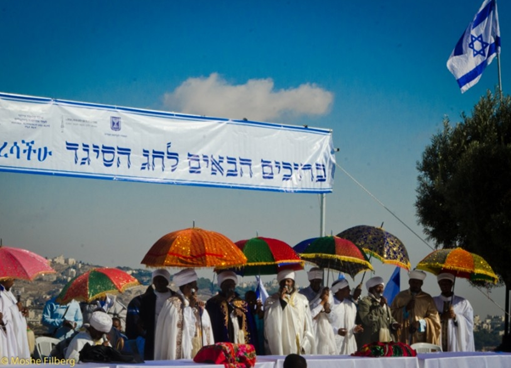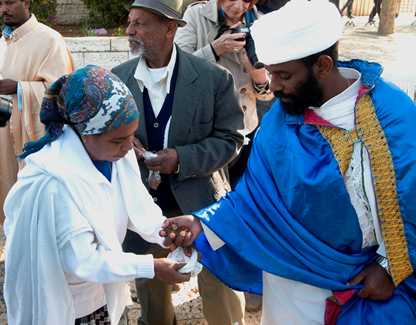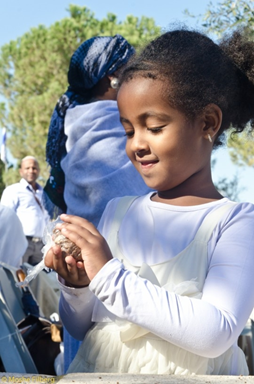The Sigd Festival Comes Home to Jerusalem

“Last year,” said Orly Sahalo, a 21-year-old Israeli of Ethiopian descent, “I arrived only at the end, and I missed out.” She was talking about the Sigd festival, which recently took place in Jerusalem. In Ge'ez, the liturgical language of Ethiopia, “Sigd” means prostration. On the Sigd, Ethiopian Jews, before their mass immigration to Israel, would ascend a mountaintop, pray, read from the Bible, and affirm their desire to return to Jerusalem. Now they are in Jerusalem, and the Sigd has become a national holiday in Israel.
This year, Orly Sahalo was not going to miss out on the full Sigd experience. Encouraged by her boyfriend, the 28-year-old Ethiopian-Israeli photographer Gidon Agaza, she turned up early at the Armon Hanatziv Promenade in Jerusalem, where thousands of Ethiopian Israelis were gathered to celebrate the holiday. “I had goose bumps,” she described her reaction. “I saw all the women dressed in white, lifting their hands, and the qessotch”—the traditional religious leaders of the Ethiopian Jews—“using their instruments,” the drums and trumpets accompanying the prayers, “just as it is written in the Bible.”

Photo courtesy of Moshe Filberg.
Indeed, this year Sahalo also attended preliminary educational events before the festival, “so that I could understand the holiday. I wanted to be able to answer questions about the Sigd if people happened to ask me, and to know for myself what was practiced in Ethiopia.”
One of those educational events was a talk on the eve of the festival, at Ramat Gan’s Bar Ilan University, by Mula Zerihoon, a 40-year old qes who was ordained in Israel. The Sigd, he explained, “is based on the times of Ezra and Nehemiah, when, after 70 years in exile, the Jews returned from Babylon to the Land of Israel. In Jerusalem, they held a day of fasting, repentance, teaching of the Torah, and prayer.” In Ethiopia, he recalled, “when we climbed the mountain, we felt Jerusalem in our heart of hearts. This deeply impacted our Judaism. Jews came from afar, two or three days, on foot, on horses, and on mules, in order to have the chance to hear Torah from the qessotch. The people learned and were strengthened.”

Photo courtesy of Moshe Filberg.
The Book of Nehemiah states that after the Jews returned to Jerusalem, “all the people gathered themselves together as one man into the broad place that was before the water gate, and they spoke unto Ezra the Scribe to bring the book of the Torah of Moses, which the Lord had commanded, to Israel.” Today, that broad place, Jerusalem’s Armon Hanatziv Promenade, overlooks the Temple Mount and offers an unobstructed view of the walls of the Old City. On the day of this year’s Sigd, dozens of qessotch from across Israel assembled there beneath colorful umbrellas on a platform draped with the flags of Israel and Jerusalem. Chanting in Ge’ez, they praised God and asked for forgiveness and blessings for the Jewish people. They read selections from Nehemiah, Exodus, and Deuteronomy to the congregation, dealing with the giving of the Ten Commandments and the return from exile. They first read in Ge’ez and then translated into Amharic.
Throughout the morning and afternoon, Gidon Agaza snapped pictures of the qessotch and worshipers. “I have been attending the festival for 13 years,” he said. “Each and every year that I come, I am moved anew to see mothers praying from the heart. I have a large archive of Sigd celebrations. I need these photographs in order to explain to people the Ethiopian community and its traditions.”
At a nearby teaching tent, Shoshana Ben-Dor and Ziva Mekonen-Degu offered instruction in the order and meaning of the day’s prayers to some 80 visitors. Most of them were young adults. In collaboration with the qessotch, the two women have been preparing a mahzor, a prayer book, for the Sigd, in Ge’ez, Amharic, and Hebrew. It is the first of its kind, slated to be published by the time of next year’s festival. They hope it will make the holiday accessible to more people.
Ben-Dor believes that all Jews, not just Ethiopian Jews, can benefit from the holiday’s celebration. “The Sigd brings together elements that exist in several Jewish holidays in a way that no other Jewish holiday does,” she says. “It has aspects of repentance—asking for mercy and hoping that God has forgiven us—that are found in the High Holidays.” In addition, she explains, “it has the mourning for Jerusalem found in Tisha B’Av and the return to Zion found in Yom Ha’atzma’ut [Israel’s Independence Day]. And it has the covenant and the giving of the Torah, which are found in Shavuot.” In sum, she says, the Sigd “is the only day in the entire calendar that brings these all together—and includes an annual renewal of the covenant. Thus, there is an importance in the Sigd for all Jews.”

Photo courtesy of Irving Schild.

Photo courtesy of Moshe Filberg.
Orly Sahalo was especially impressed by the activities for children and young adults that she saw at Armon Hanatziv. “They will learn,” she said, “and this holiday will have a continuation.” She was also “moved to see the qessotch distributing handfuls of Jerusalem soil to the worshipers. People are able to take a piece of Jerusalem home with them, just as in Ethiopia they were able to take home soil from the mountain on which the Sigd was held.”
Shai Afsai is a writer and teacher whose works have appeared in a number of literary and historical journals.
Comments are closed for this article.



I agree with Shoshana Ben-Dor's statement that Sigd "is the only day in the entire calendar that brings these [repentance, mourning for Temple, Zion, Torah, etc] all together—and includes an annual renewal of the covenant. Thus, there is an importance in the Sigd for all Jews.”